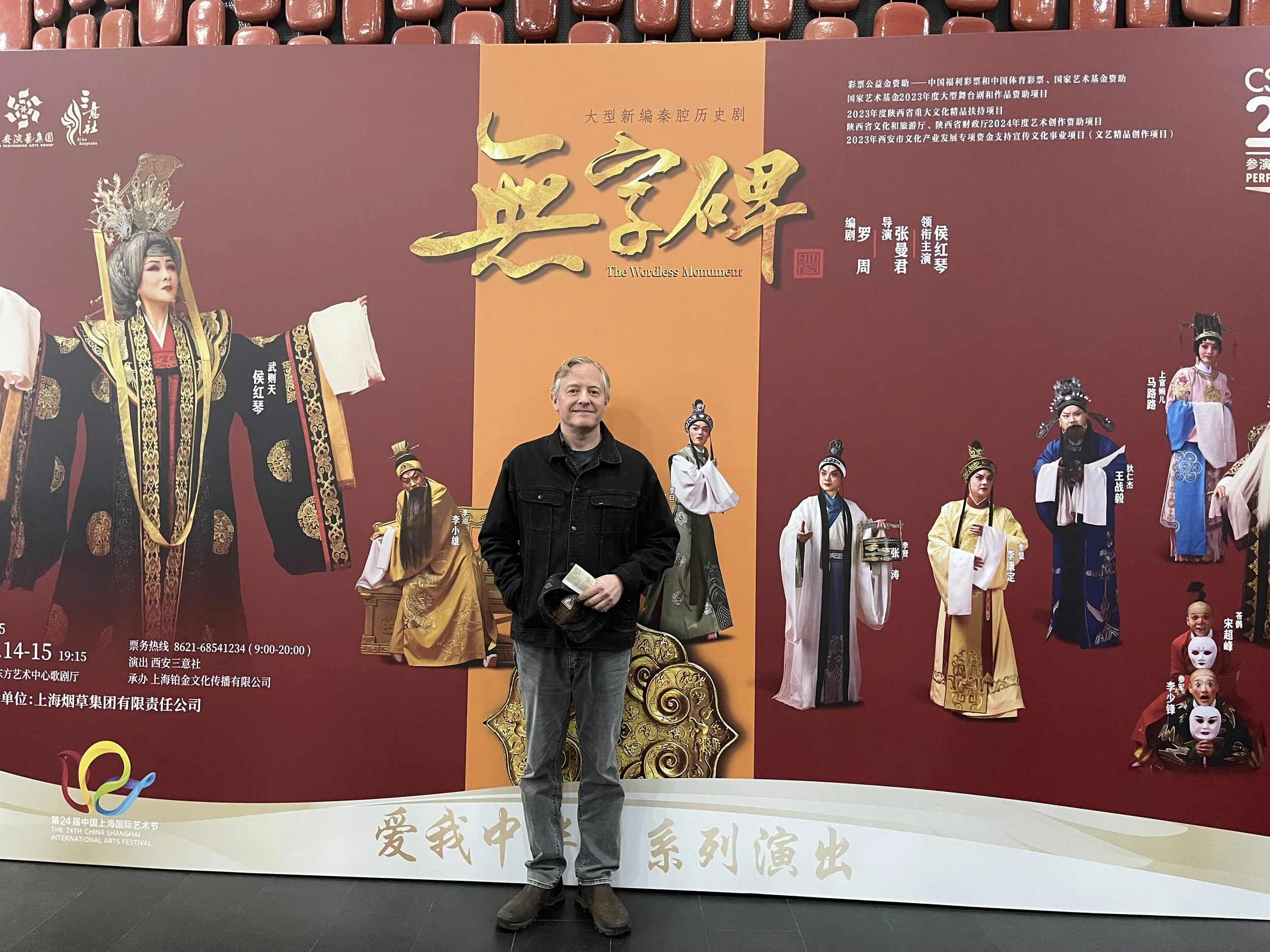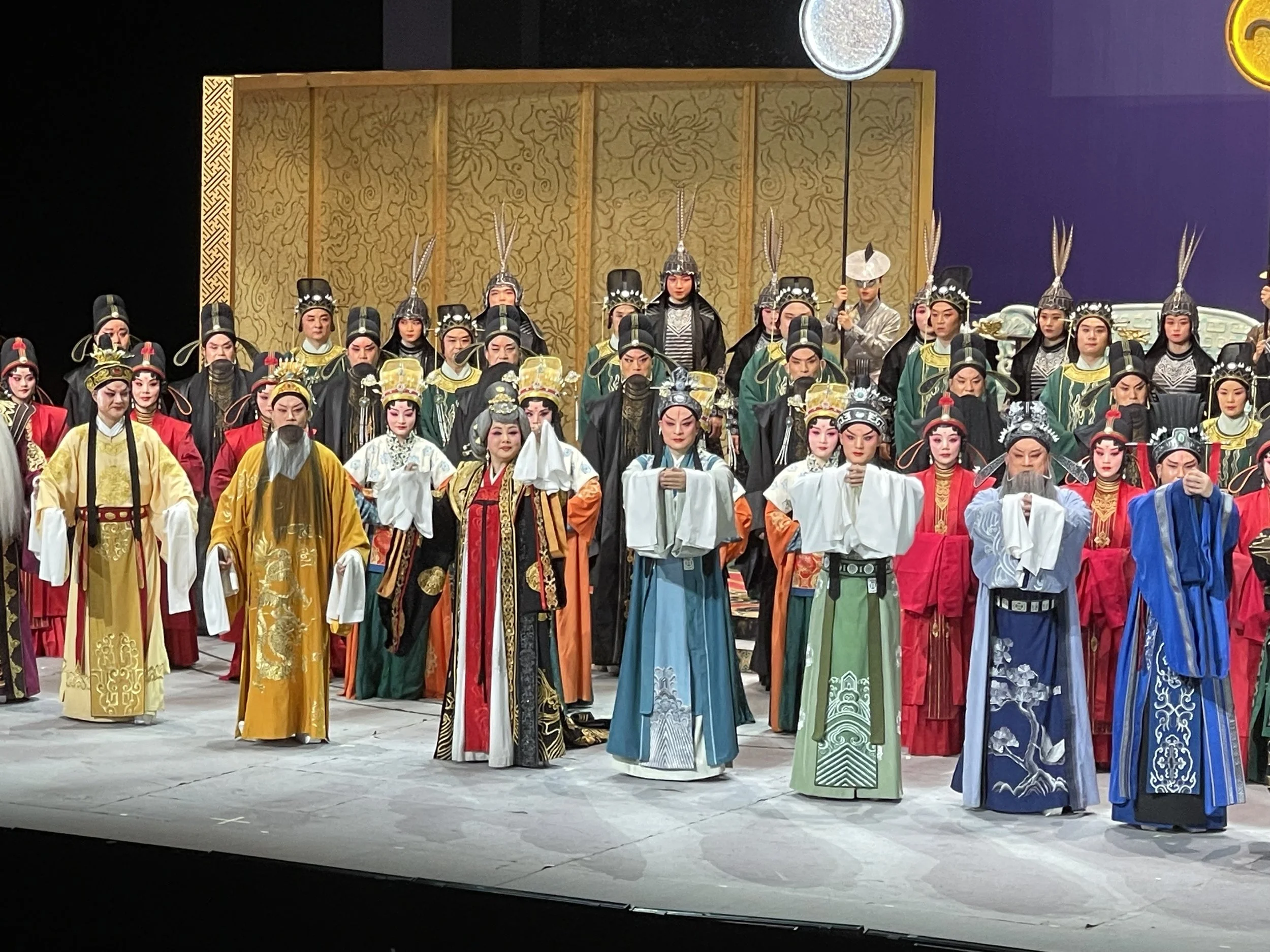Last night, my colleague Li Yanfeng invited me to join him and his family and friends for a viewing of the opera 无字碑 The Wordless Monument. This opera follows the story of the rise of the Tang Empress Wu Zetian to power as the first and only female emperor of China. Written and directed by women, it deeply humanizes the story of a legendary and mysterious female leader in Chinese history. The story explores her difficult relationships with her husband, the dying emperor Tang Gaozong, as well as her three sons. In addition, she experiences some kerfuffles with her ministers. Though she emerges triumphantly as the paramount leader, she has sacrificed her personal relations and well being “for the sake of the nation.” There’s a message here, and it’s full of the ambiguities and complexities that a good story should be.
We watched the performance in the 东方艺术文化中心 known as the Shanghai Oriental Art Center in Pudong. The performance lasted nearly three hours and it was rather difficult to sit in those seats for that long, but worth the effort. The acting and singing were tremendous as was the staging and the costumes. For those who have the opportunity, I highly recommend this production. I believe it combines some very modern techniques of stagecraft and storytelling clothed in a traditional vibe, with the best of Chinese opera traditions thrown in for good measure, including a pair of comedic acrobats. The woman who plays the role of Empress Wu Zetian was simply fabulous, and earning nearly a standing ovation by the rather conservative and picky Shanghai audience. There was plenty of clapping after some of the great arias by lead actors, and I could tell the audience was impressed, even if in true Shanghai style they refused to show it completely.
If there’s one caveat on my part, it’s that the production could use English translation for viewers who aren’t fluent in written Chinese. I was able to understand most of the dialogue through reading the Chinese language subtitles on the side screen, but it was a course in speed reading for me and I probably missed a few subtleties. In an international city like Shanghai, there’s no reason why this performance couldn’t be more attractive to an international audience.
Here is a review of the production by an expert who sums it up much better than I can. I’ve used GPT to make a translation into English, and you can read the original Chinese language review here.
“The Earth Has No Words, But the Sun and Moon Speak: A Review of the New Qinqiang Historical Opera The Wordless Monument”
By Xiao Yunru 肖云儒 | February 21, 2025 | Published in Literature & Art Daily (文艺报)
Opening Reflections
Watching The Wordless Monument, the newly composed Qinqiang opera performed by Xi’an’s renowned San Yi Shetroupe, one is not only aesthetically moved but intellectually stirred. With Luo Zhou as playwright, Zhang Manjunas director, and Hou Hongqin in the lead role, this opera achieves historical depth, emotional richness, and literary sophistication.
The creators found a compelling entry point: the tangled web of imperial power, duty, and familial affection. Into this web they wove the storm of historical upheaval, fateful entanglements, inner torment, and life’s bitter truths—casting light upon these threads, then magnifying and unfolding them, pushing ever deeper like a dramatist’s microscope.
Moral Conflict in Historical Drama
In the writing of historical dramas, tension often arises between historical judgment, moral reckoning, and emotional truth. Artists must tread a narrow path, forced to find dramatic expression amid such contradictions.
In the rigid Confucian society of imperial China—a world dominated by ancestral power and male discourse—the rise of a woman to the throne was bound to provoke resistance on all fronts: the court, the people, even the family. Wu Zetian’s climb to power—overthrowing her own sons to become China’s only female emperor—is a rare phenomenon. Like a particle accelerator, it intensifies and quickens the development of dramatic conflict.
The creators take a macro-historical and deeply humane perspective, showing Wu’s burden of ruling the empire alongside her inner brilliance—thus achieving a synthesis of historical and moral judgment.
Plot Structure & Emotional Arcs
The opera unfolds in cascading waves of conflict, with four major emotional and political climaxes charting Wu Zetian’s bloody path to power:
First Crisis: A tense bedside conversation between Wu and her ailing husband, Emperor Gaozong (Li Zhi), hints at her first step toward power.
Second Crisis: Exiled son Li Xian, in a final act of filial piety, offers his mother homemade buns while in mourning. The encounter erupts into rupture, severing their bond.
Third Crisis: Wu uses a comedic “military skit” to publicly expose her son Li Xian’s ambitions, then condemns him for lacking the capacity to restore the empire.
Fourth Crisis: Pretending to abdicate to Li Dan, Wu witnesses his fear—his brothers all gone—and takes the throne herself.
In the process, she buries Li Zhi, exiles Li Xian, deposes Li Xian (the younger), and terrifies Li Dan. Her motto becomes: “Depose the Son to Save the Nation.” This core idea—that the Li clan was no longer capable of rejuvenating the Tang Dynasty—is presented as a historically valid justification for her rise.
Literary Depth and Psychological Complexity
The opera’s literary merit lies in how it embeds deep psychological activity within its soaring lyrics and layered action. Every character carries a full, turbulent emotional life. The interweaving of external conflict and internal suffering creates a richly aesthetic world.
But it doesn’t stop there.
Wu Zetian is shown as both oppressor and victim, both perpetrator and sufferer. The arrows she shoots at others—her sons—ultimately wound her as well. The playwright powerfully conveys her torn, tortured psyche.
A standout moment: upon hearing of Li Xian’s suicide, she nearly collapses on the throne. After banishing Li Dan, she rises again, wanting to bring him back.
She laments:
“Once I’ve taken the throne, I’ve forsaken all else—
Forsaken the gentle grace of a virtuous son,
Forsaken tenderness, forsaken the joy of motherhood and marital bliss,
Forsaken the serenity of clouds and wind—
All to stand alone under the sun and moon, facing wind and snow.”
To Di Renjie, she confesses:
“I lost the late emperor in Zhen Guan Hall,
My son Xian at Ci’en Temple,
My son Xian’er in the palace,
And Dan on the royal mound.
I am utterly, terribly alone. How did it come to this?”
This is the raw cry of a woman who has sacrificed every joy of womanhood and motherhood to ascend the throne.
A Female Gaze and Emotional Ambivalence
This opera, featuring a female protagonist and largely crafted by female creators—playwright, director, and lead actor—presents Wu Zetian’s complex soul with a rare depth of understanding.
One senses that the creators themselves are emotionally caught in Wu’s web: loving and hating her, admiring her and grieving her, praising yet questioning her. This emotional ambivalence shared between creator and character is one of the surest paths to artistic greatness.
Symbolism and Visual Language
The Wordless Monument employs three major symbolic images to weave together its narrative and themes:
The Dragon Throne (龙椅)
Introduced ceremonially before any actors appear
Repeatedly appears as two thrones, then one
Symbolizes both imperial authority and the fragmentation of power
The Sun and Moon Apparition (日月灵象)
A dazzling, surreal image representing Heaven’s Mandate
Appears whenever Wu hesitates on her path to power
Suggests that her rule, though controversial, aligns with cosmic destiny
Her chosen name, “Zhao” (曌), literally means “the Sun shines in the sky,” affirming her alignment with the Way of Heaven
The Wordless Stele (无字碑)
The opera’s namesake and central motif
A real monument that still stands at Wu Zetian’s tomb in Qianling
Symbolizes the inexpressibility of moral judgment, the ambiguity of history, and the emotional cost of power
She sings:
“No carving can capture the sorrow I endured,
No script can bear the weight I held alone—*
Why write of virtuous rule or peace under Heaven?*
Let the stele remain blank, let silence be my epitaph.”*
This silence—the blank stele—speaks louder than any inscription.
The symbols of “the blank,” “the void,” and “Zhao (Sunlight)” resonate together. The “Wordless Monument” is a core metaphor, encapsulating the opera’s inner tension and spiritual depth.
Aesthetic Vision and Artistic Execution
The opera powerfully engages not only with the “signifier” (symbols, language) but also invokes the “signified” (the vast philosophical meanings beyond them). This invites audiences into a realm of aesthetic re-creation—an experience both evocative and profound.
Conclusion: Wu Zetian and the Moral Arc of History
The Wordless Monument tells the story of how the “Great Way is not named,” how “true virtue appears unkind,”and how the Mandate of Heaven can override familial bonds and societal norms.
Wu Zetian’s image ascends not just into history, but into a vision of moral transcendence—establishing meaning for the people, opening peace for future generations.
Performance Notes
Xi’an San Yi She, one of the most respected traditional opera troupes in China (on par with Xi’an Yisu She), brought the production to life with a powerhouse cast that included four Plum Blossom Award winners.
Stage Design: Simple yet expressive, full of hidden symbolic meaning in form and color
Music: Blends Qinqiang with modern symphonic elements, achieving an atmosphere both rich and tragic
Author Xiao Yunru is a cultural critic and Distinguished Professor at Xi’an Jiaotong University.

